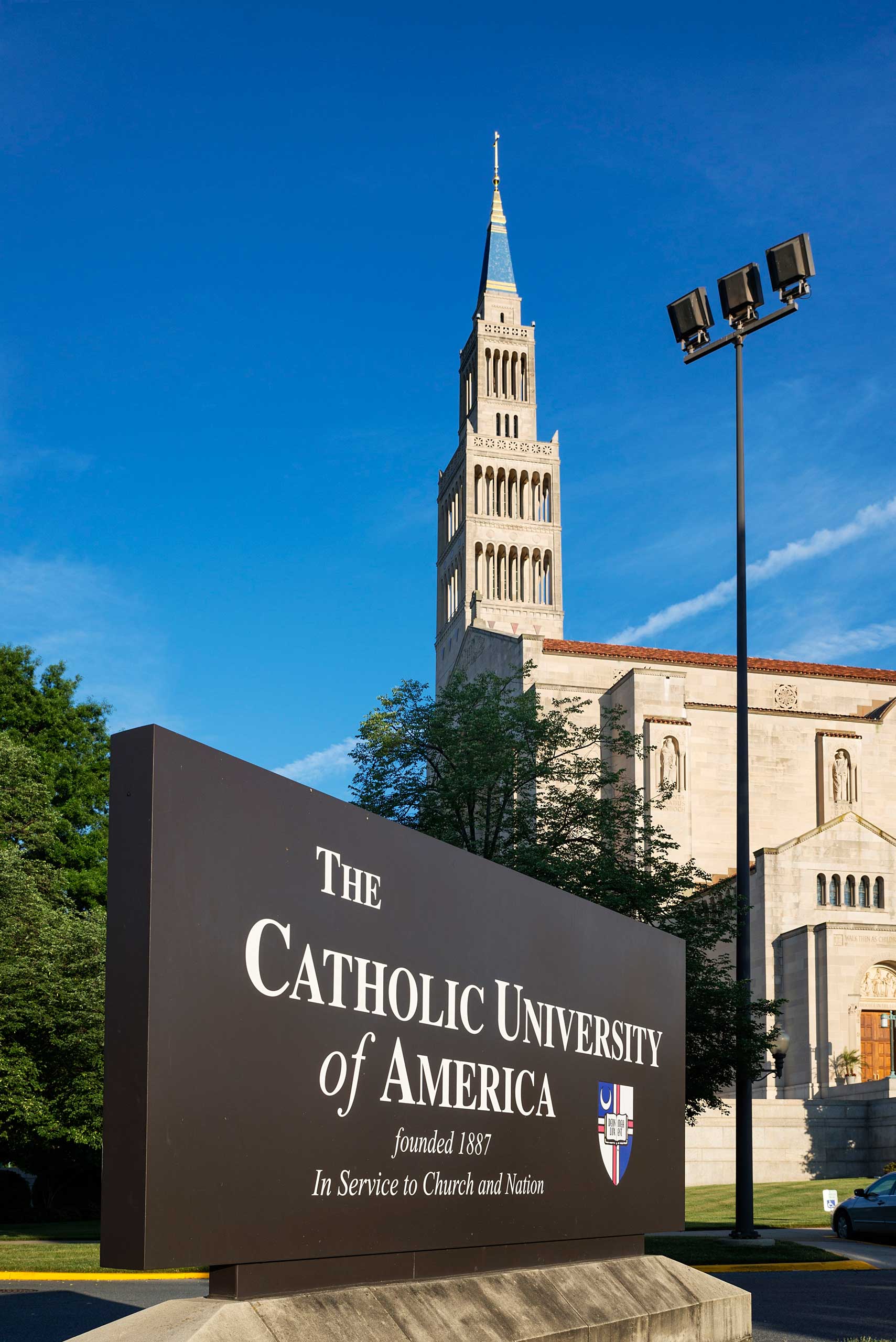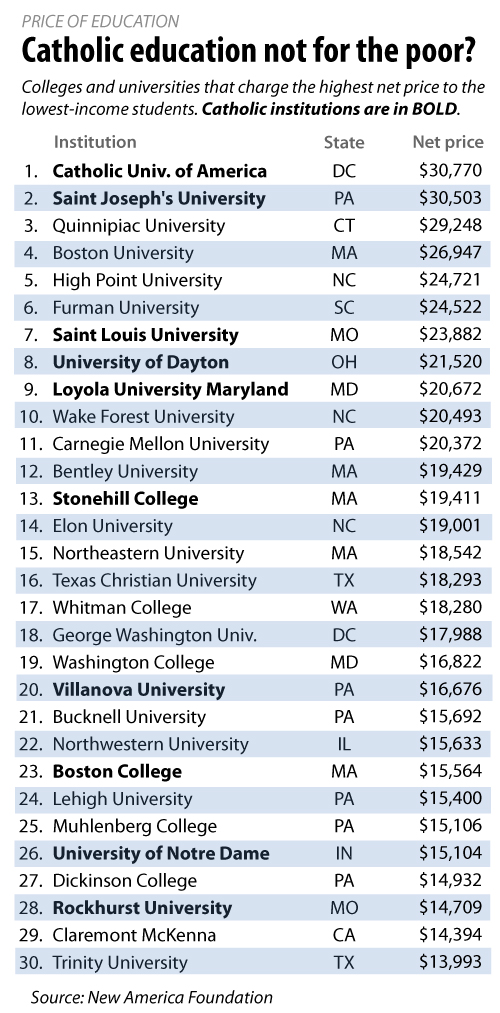
At Catholic University of America in Washington, D.C., officials sometimes bring in low-income applicants and their families for counseling. The point of the sessions is not to encourage the students to attend, but to suggest they consider going somewhere cheaper.
The university needs to spend its financial aid to attract “higher-end students,” says W. Michael Hendricks, vice president for enrollment management — the kind of high-achieving, wealthy students that can improve a school’s prestige and bolster its bottom line. And he says the school has another, seemingly paradoxical rationale for dissuading low-income students: its Catholic identity makes the university hesitant to burden low-income families with debt. “It totally flies in the face of our mission,” Hendricks says.
Despite such sentiment, Catholic University charges the highest net price in America for low-income students — the cost once discounts and financial aid are taken into account — according to a study by the New America Foundation based on information reported to the U.S. Department of Education by the institutions themselves. And they have plenty of company among peer institutions.
At a time of escalating worry over access to higher education, Catholic institutions are in the uncomfortable position of comprising five of the 10 most expensive private universities for low-income students, and 10 of the top 28, the study found.
Some Catholic colleges “seem to have departed from what you would assume the principles of their faith would have compelled them to do,” says Kati Haycock, president of the Education Trust, a nonprofit organization that advocates for low-income students.
“It’s disturbing that institutions give money in these very difficult times to students who don’t need it,” Haycock said, and “don’t focus their resources on those who absolutely need it the most.”
Colleges that charge the most to poor families, the New America Foundation researchers said, are giving increasing proportions of their financial aid to wealthier students, whose families can afford to pay the rest of the tuition. These kids often come from well-funded suburban high schools and have comparatively higher entrance examination scores and high-school grades that improve the colleges’ standings in rankings.
Officials at some Catholic colleges and universities say that, as a matter of survival, they feel compelled to spread small amounts of financial aid to a large number of these higher-income students, rather than give more of it to the poor. By making many small grants, they say, they can attract the number of tuition-paying students needed to keep the colleges in business.
It’s a sensitive issue for the nation’s 200-plus Catholic colleges, given that church teaching calls for a “preferential option for the poor,” which the U.S. Catholic Conference of Catholic Bishops has interpreted to mean that “poor people have the first claim on limited resources.”
Some Catholic institutions do succeed at keeping down costs for students with family earnings low enough to qualify for federal Pell grants — generally, $30,000 a year or less. But others are charging those students a net price that is equal to two-thirds or more of their families’ entire annual incomes.
At Catholic University, for example, the poorest students pay an average annual net price of $30,770. Philadelphia-based Saint Joseph’s University charges its poorest students $30,503; Saint Louis University, $23,882; the University of Dayton, $21,520; and Loyola University Maryland, $20,672.

These schools also enroll low percentages of poor students. Only between 13% and 15% of the students they enroll come from families with incomes low enough to qualify for Pell grants.
Five other Catholic colleges and universities, however, are among the 10 private colleges at the other end of the spectrum, providing a lower-cost education to comparatively high proportions of Pell students.
Saint Thomas University in Miami, for example, has an average net price of $8,072 for its lowest-income students, who make up more than half of its enrollment. Others with high proportions of low-income students and low net prices are Saint Mary-of-the-Woods College and Calumet College of Saint Joseph in Indiana, Holy Names University in Oakland, Calif., and Saint Francis College in Brooklyn.
“Some Catholic colleges are able to place a high priority on meeting the needs of very low-income families. Others have limited resources, making it more difficult to address those financial needs,” says Michael Galligan-Stierle, president of the Association of Catholic Colleges and Universities. “While embracing their faith tradition, our institutions still must contend with the realities of education costs that are true of any college or university in the United States.”
In fact, some of the Catholic colleges that charge the most have robust wealth in the form of their endowments. Saint Louis University has a $956 million endowment; the University of Dayton, $442 million; Catholic University, $264 million; Saint Joseph’s, $193 million; and Loyola of Maryland, $177 million, according to the National Association of College and University Business Officers. Among the other Catholic universities with high net prices for low-income students, Villanova University has an endowment of $419 million, while Notre Dame has a towering $6.9 billion in the bank.
Gerald Beyer, a theology professor at Villanova, thinks high-cost Catholic colleges should try harder to move away from the “preferential option for the rich” adopted by many on-Catholic private private universities in the U.S. “By the very nature of their mission, Catholic universities must fight against this trend,” Beyer says.
He points to an overlooked passage from Pope John Paul II’s 1990 document Ex Corde Ecclesiae, which says that Catholic universities should seek “to make university education accessible to all those who are able to benefit from it, especially the poor or members of minority groups who customarily have been deprived of it.”
Jesuit Catholic colleges and universities in particular stress principles of social justice, but three of the order’s universities rank high on the list of colleges that accept few Pell students and leave them with high net costs: Saint Joseph’s University, Saint Louis University, and Loyola University Maryland.
Saint Joseph’s spokesman Joseph Lunardi says the school takes the issue seriously. At an October meeting, he says trustees discussed its comparatively low proportion of Pell students, asking whether the university is “losing ground in their mission.”
Lunardi added that the proportion of Pell students would be higher if 1,000 part-time students were included, since 40% to 50% of them are low-income, and that the net-price figures collected by the federal government and used in the report include only students who receive federal financial aid, not all students.
Saint Louis University and Loyola-Maryland declined to comment.
The University of Dayton, which is affiliated with the Marianist order, said that, since the 2011-12 academic year covered by the New America study, it has instituted a four-year guarantee that students’ net price won’t increase and has taken other steps that are beginning to result in the admission of more Pell students and less student debt.
Of all the nation’s colleges, Catholic University is most closely identified with the institutional church. Its bylaws require that 18 of its 48 trustees be bishops. An annual collection in parishes across the country raises about $5 million for the university, which goes for scholarships issued through participating parishes.
Hendricks, the enrollment manager, says the school is “always struggling” with the moral implications of admission practices. “At Catholic schools in particular, we like to stay need-blind,” he says, referring to a waning practice under which universities accept applicants regardless of their ability to pay. “That’s our mission. It’s getting more and more expensive to do that.”
This story was produced by The Hechinger Report, a nonprofit, independent news website focused on inequality and innovation in education.
More Must-Reads From TIME
- The 100 Most Influential People of 2024
- The Revolution of Yulia Navalnaya
- 6 Compliments That Land Every Time
- What's the Deal With the Bitcoin Halving?
- If You're Dating Right Now , You're Brave: Column
- The AI That Could Heal a Divided Internet
- Fallout Is a Brilliant Model for the Future of Video Game Adaptations
- Want Weekly Recs on What to Watch, Read, and More? Sign Up for Worth Your Time
Contact us at letters@time.com